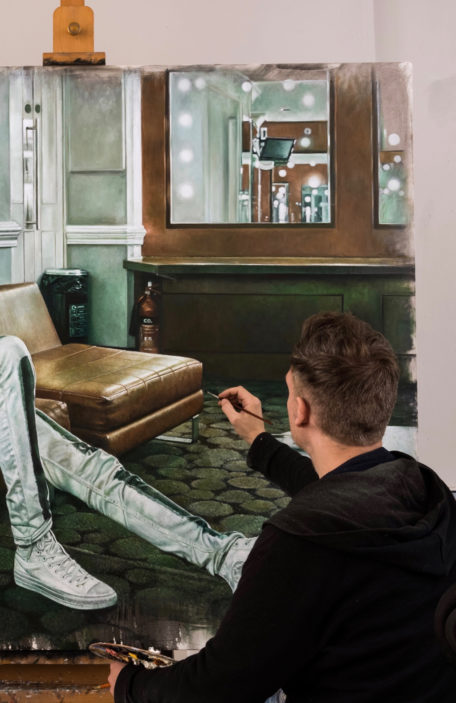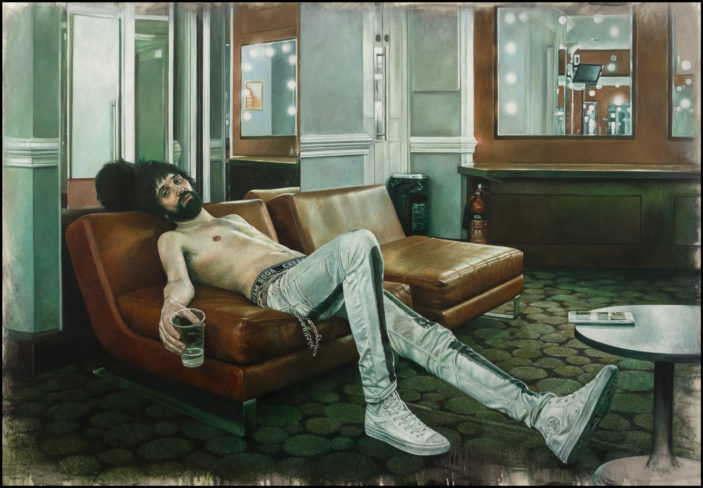
When you’re at a cracking live gig it’s not hard to be consumed by the performance of a frontman, and even more so when the frontman – or men, in this instance – are Tom Meighan and Serge Pizzorno of Kasabian. It’s worth taking a moment, however, to focus on the other performers on the stage because you never quite know what wealth of talent is lurking upstage. This is absolutely the case with Kasabian’s saxophonist, Andrew Kinsman.
I first became aware of Andrew through watching a plethora of YouTube videos of Kasabian’s live shows. After a while I learned that he was also an artist. Now, at this point it would normally be a case of thinking it’s just a bit of a hobby on the side and getting back on with life, enjoying their musical talents and thinking no more about it, but with Andrew Kinsman it’s a very different scenario. He’s a man with such depth and breadth of talent that it’s breathtaking.
His life as an artist would be enough to make you realise that he’s incredibly gifted, but then he throws in the musical ability – touring and recording with Kasabian and Noel Gallagher, plus being a very accomplished jazz performer in his own right – and you start to see that he’s a fairly special chap.
After I spent some time looking through his portfolio of work I wanted to get to know him a bit more and he very generously gave of his time to discuss this unusual cross-over of talents.
I understand you started painting at quite a young age, working with oils from around ten years of age. That’s quite an advanced medium for someone so young – had you previously drawn or painted or did you leap straight into art and start with oils?
I started drawing around six or seven years old. I still remember obsessively drawing with my older brothers, but when I moved to oils at eleven I quickly discovered I was out of my depth. I tried to paint my Mum from life, which inevitably was a disaster.
Your first oil painting sold to family friends when you were just twelve – can you remember the piece?
I sold a few around that time and they were mainly still lifes with the occasional animal portrait. I didn’t have the skill to paint human portraits until much later on.
I’ve seen you’re self-taught in both your music and your painting, which is rather astonishing, but has there been any formal training at all subsequently?
I’ve never been able to perform in front of a teacher. This is true in music and art. I need to go away and find out how to do things in my own time and manner.
Who have your inspirations been thus far for your painting? I see a blend of hyper-realism and romanticism – do you feel you have a particular identity as an artist or are you still developing that? Has it evolved over time as you’ve grown older?
As a teenager I wanted all my paintings to look as photographic as possible but slowly over time I’ve naturally loosened up. I still look at artists like John Singer Sargent and try to emulate his technique as well as his sheer industriousness. He gave his life to his art. This is what I aspire to be.
When you are planning an artwork do you have an absolute idea in your head for how it will look when completed or is it more dynamic a process, taking shape as you work?
I can’t start a painting unless I have a clear idea of how I want the finished work to look, even if it’s just a sketch. This isn’t to say that it won’t change completely half way through, as is often the case.
One of your recent pieces had the subject covered in plastic or a sheer fabric and I couldn’t stop looking at it. I can’t possibly comprehend how that can be achieved. When you look at fabrics or textures are you able to deconstruct them mentally to recreate them in a painting, or is it an interpretation of light and dark?
It’s all about deconstructing an image that excites me. Just how much of the original image do I have to add before it conveys a true depiction? This is much more challenging than painting in every last detail.
Not only are you an extraordinarily talented painter but you also have a very successful career as a musician, touring and recording with many contemporary musicians, including Noel Gallagher and Kasabian. Is music something that has always been in your life? What is it about the sax that drew you to it over other instruments? Is it the only instrument you play?
I also play the flute and piano (I should say learning the piano). I started really getting into jazz around the age of fifteen and the tenor sax was the instrument that always stood out over everything else. I instantly fell in love with the variety of tones that these players could achieve just like a vocalist. You’ll see what I mean when you listen to Stan Getz next to John Coltrane. Every player has his or her individual sound and style.
What has been the highlight of your musical career to date?
Doing the recent two legs of the Kasabian UK tour is pretty high up there. I loved every minute of it. The Royal Albert Hall for the Teenage Cancer Trust was really special, especially as I got to paint Serge backstage after the show.

Tell me about this painting.
The original image was taken by the band’s official photographer, Neil Bedford, and it was arranged by Neil and Serge that this would be a good image for me to work on. I chatted with Serge at the Thetford Forest gig about the style we should go for and initially we talked about making it almost baroque in style, dark shadows and chiaroscuro reminiscent of Caravaggio.
In the end I wanted to give it a more contemporary feel. I love the saturated colour palette of films like ‘Green Room’ or ‘Fight Club’ amongst others but still wanted it to be a painting in its own right, hence leaving much of the grey wash of the first glaze. I thought it important to include much of the background to really get the feel of this environment. I still think the pose nods to past religious paintings but that’s open to interpretation.
I should add that I’ve changed quite a lot from Neil’s photo. I pretty much made up this colour palette as he sent it to me in black and white, plus due to his wide angle lens the figure and the background was very much stretched almost giving it that ‘falling off the ship’ appearance, so I straightened the perspective and took out a few more details in the room.

Although both are highly creative pursuits with many similarities there’s also a lot of differences between being a performer on stage and being an artist secreted away working on a painting – I can imagine both are equally demanding but do you feel a greater affinity with one over the other based on your personality?
I love the instant gratification of playing music as well as the social aspect. I’ve met so many great people through playing and recording music who are still my closest friends. The painting, however, is my first love. To quote artist Maggie Hambling: “You must make your art your best friend”. I think that’s very true.
Is there any crossover between your painting and music? Not suggesting you try and play sax whilst you paint, rather do you listen to music when you work or do you need peace and quiet? If you do listen to music can you give me an idea of what might be playing on the stereo?
I’m always listening to music when painting but never Jazz. This is far too distracting as often I’ll hear a great solo and want to transcribe it. I generally listen to something with plenty of space, and at the moment i’m listening to Nils Frahm.
Do you have any particular goals or dreams for either branch of your talents?
I want to do much more travelling with my art, painting from life and creating more of a journal of works. Also, I’d really like to explore this ‘backstage/behind the scenes’ idea, especially with my musical background. I’ve also painted actors as well as musicians backstage but I think this idea could extend to other fields.
If you’re interested in seeing more of Andrew’s extensive and phenomenal work I highly recommend having a look at his website HERE.
Headline Photo Credit: Neil Bedford
